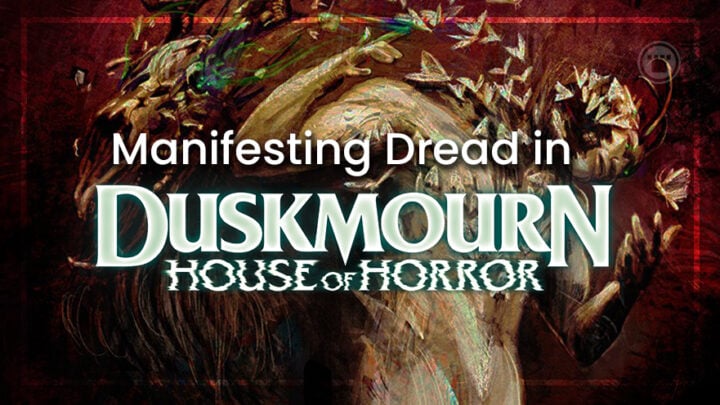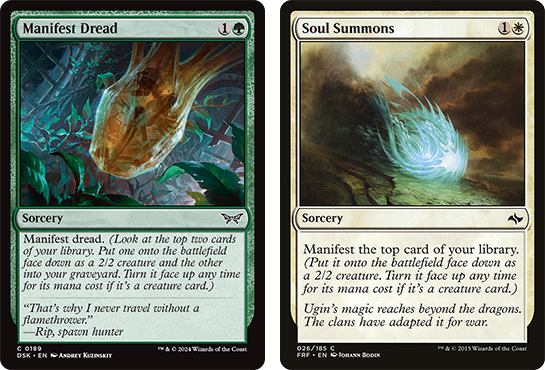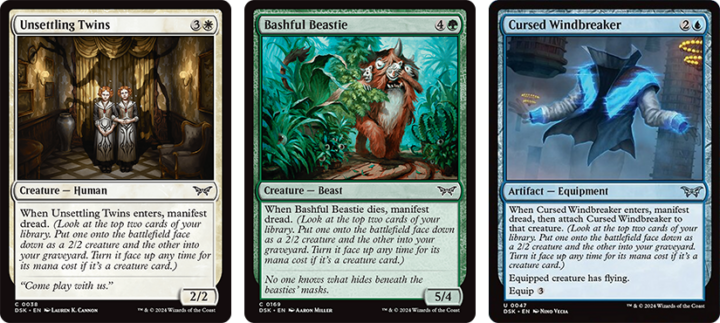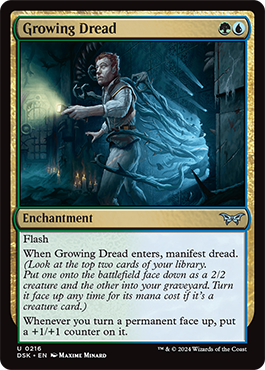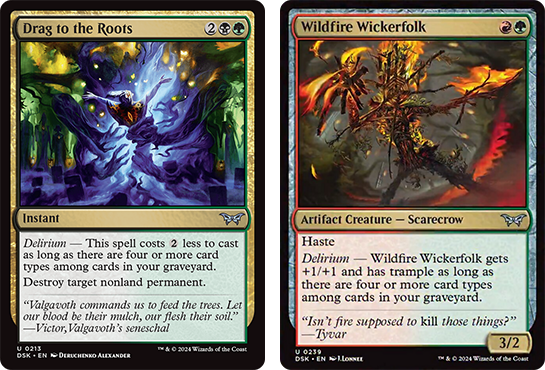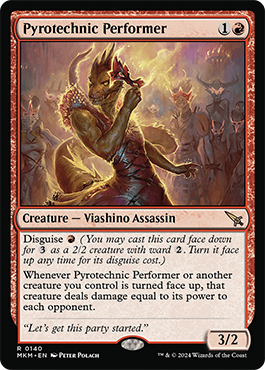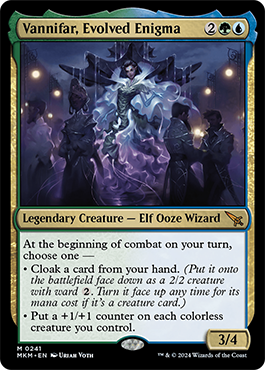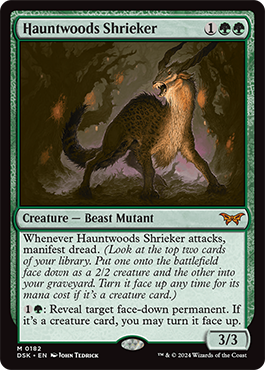We’re in the midst of Duskmourn: House of Horrors preview season and it releases later this month, on September 27th . The set contains lots of really cool mechanics, but the one that has caught my eye the most is “Manifest Dread.” In this article, I’ll break down how the mechanic works and how I think it’ll perform in the Limited formats.
At first glance, Manifest Dread might just seem like a slightly different take on the original Manifest mechanic, which first appeared in Fate Reforged. But it’s substantially stronger because it does so much more.
In Fate Reforged, Manifest allowed you to put a card from the top of your library into play face down as a 2/2. Manifest Dread does the same thing, but with some extra steps. Instead of giving you no control over what gets put into play face down, it gives you some card selection.
This is because Manifest Dread looks at the top two cards of your library and you choose one to put into play face down as a 2/2. In other words, you have a much higher chance of putting a creature face down. And if you do that, you’re talking about a 2/2 with some pretty serious upside.
Your opponent can never be sure that the creature lurking underneath that soft 2/2 body isn’t something that can do lethal damage to them, or run over their own 2/2 blocker. While all of that was true with the original manifest, it’s going to be relevant far more often when you get to choose between two cards.
Then, the fact you put the other card into the graveyard is no small thing. Like most spooky sets, Duskmourn: House of Horrors prominently features the graveyard and many decks will be able to get value out of the card they put in the graveyard, too.
MANIFEST DREAD IS PRICED TO MOVE AT COMMON AND UNCOMMON
As good as Manifest Dread can be, it does need to have a reasonable mana cost associated with it for it to be worthwhile. Luckily, this is certainly the case, even at lower rarities.
One of the easiest ways to evaluate the mechanic is to break down whether or not you’d be playing the card if it just gave you a 2/2 token instead of manifesting dread. If the answer is “yes,” you should be very interested in playing that card. That’s because manifest dread effectively gives you a 2/2 with massive upside.
Unsettling Twins, Bashful Beastie, and Cursed Windbreaker are all great examples of this. You’d always play a 4-mana 2/2 that makes a 2/2 token. You’d feel pretty good about playing a 5-mana 5/4 that makes a 2/2 when it dies. And you would feel great about playing an Equipment that grants flying, makes a 2/2 token, and attaches to the token for free. And all of these cards are substantially better than that.
HOW MANIFEST DREAD FITS IN THE FORMAT
While Manifest Dread is a strong and efficiently costed mechanic, there are also four archetypes in this set that can leverage even more value out of the mechanic.
This is most obviously the case in Blue-Green, which is a dedicated Manifest Dread deck. The color pair not only features many cards that let you manifest dread, it also has cards that pay you off for having face down creatures. For example, Growing Dread puts a +1/+1 counter on permanents you turn face up.
There are also two Delirium decks in the format – Black-Green and and Red-Green. Delirium gives you some kind of bonus if you have four or more card types among cards in your graveyard. In those color pairs, putting a card with the right type into your graveyard is going to be just as important as putting the right card into play face down.
Lastly, Black-White is a reanimator deck. Manifesting dread in that deck will be substantially different than doing it in any other, because you’ll frequently want to put a big creature into your graveyard to reanimate it with Rite of the Moth, instead of putting it into play as a face-down 2/2.
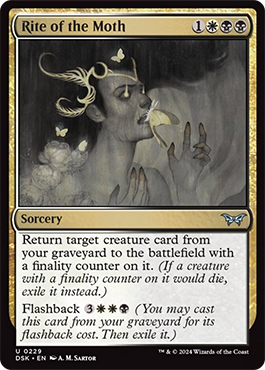
As good as Manifest Dread looks on paper, I think there’s a very good chance it will over perform as a result of plentiful synergies in the format.
HOW WILL THIS IMPACT LIMITED GAMEPLAY COMPARED TO DISGUISE/CLOAK?
This isn’t the first time this year that we’ve seen a face-down card mechanic. In Murders At Karlov Manor, we had Disguise and Cloak. This led to that format having tons of face-down 2/2s with Ward 2. While there are some obvious similarities between the two mechanics, there are also some significant differences.
First, all of that Ward 2 made removal substantially worse in Murders than it usually is. The manifest creatures in Duskmourn are considerably more vulnerable since they don’t come with Ward.
The other major difference is that in Murders you had a much better idea of what your opponent might have played face down. While the Cloak mechanic worked similarly to Manifest Dread, the only playable cards it appeared on were Rares and Mythic Rares.
You didn’t see Cloaked creatures game in and game out. This meant that you could make some educated guesses about what might be hiding under the Disguise based on what colors your opponent was playing.
That won’t be nearly as possible in this format. Manifest Dread is everywhere. You’re going to see a mysterious face-down creature in just about every game. And you’ll never have a great idea of what that creature might be, since it could be anything.
There are even some interesting mind games you can play with your opponent. For example, if the card you put into the graveyard is also a creature, your opponent is going to become very worried about what the 2/2 in play might be.
While this is certainly a flavor win, I do think this mechanic does present one very real problem – it’s going to result in some serious feel-bad moments. I think having a limited number of cards that can be face down creatures is a better experience overall, as you can make more informed decisions.
When any creature card can be face down, the RNG is much higher. While you probably won’t get blown out any more often than you normally would, it’s going to feel a lot worse when it does happen because there was just no way for you to know the outcome.
END STEP
Those are my thoughts on the Manifest Dread mechanic for Duskmourn Limited. What do you think? Am I overrating the mechanic? Underrating it? Let me know over on X!

Jacob has been playing Magic for the better part of 24 years, and he especially loves playing Magic’s Limited formats. He also holds a PhD in history from the University of Oklahoma. In 2015, he started his YouTube channel, “Nizzahon Magic,” where he combines his interests with many videos covering Magic’s competitive history. When he’s not playing Magic or making Magic content, he can be found teaching college-level history courses or caring for a menagerie of pets with his wife.

